![A transport of Jewish prisoners marches through the snow from the Bauschovitz train station to Theresienstadt. [LCID: 69720]](https://encyclopedia.ushmm.org/images/large/781755a6-1ba5-4d8e-8b2b-9f25bdf3687f.jpg)
Browse an alphabetical list of photographs. These historical images portray people, places, and events before, during, and after World War II and the Holocaust.
<< Previous | Displaying results 1-25 of 146 for "Photo" | Next >>
Tadek Soroka (right), a Pole who helped Aron and Lisa escape from Poland. This photograph was sent to the Dermans after the war. Date and place unknown.
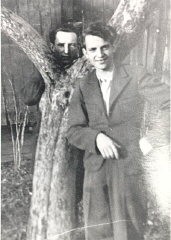
A tank guards the entrance to the Palace of Justice in Nuremberg, Germany, site of the International Military Tribunal. The trial formally opened in on November 20, 1945, just six and a half months after Germany surrendered.
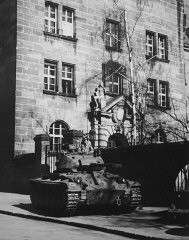
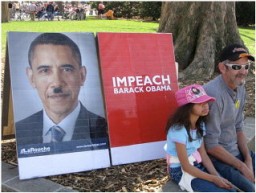
Jewish teenagers study electricity at a vocational ORT (Organization for Rehabilitation through Training) school in the Cremona displaced persons (DP) camp, Italy, 1945–1947. Shie Zoltak is standing on the far left. Standing on the far right is Shie's uncle, Abraham Lisogurski, who is the instructor.
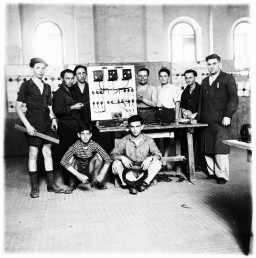
A group of Polish Jewish children (known as the "Tehran Children"), who arrived in Palestine via Iran, at the Mikveh Israel agricultural village. Palestine, February or March 1943.
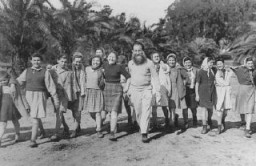
Polish Jewish refugee youth known as the "Tehran Children," who arrived in Palestine via Iran, learn agricultural skills. Ayanot, Palestine, 1943.
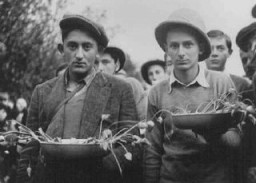
Soviet leader Joseph Stalin (left), US president Franklin D. Roosevelt (center), and British prime minister Winston S. Churchill (right) at the Tehran Conference. Tehran, Iran, between November 28 and December 1, 1943.
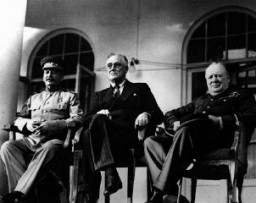
The SS Quanza was a Portuguese ship chartered by Jewish refugees attempting to escape Nazi-dominated Europe in August 1940. Passengers with valid visas were allowed to disembark in New York and Vera Cruz, but that left 81 refugees seeking asylum. On September 10, 1940, they sent this telegram to First Lady Eleanor Roosevelt to implore her for help.
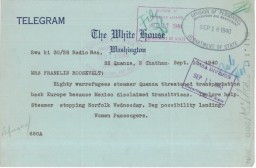
One of the tent camps used to detain Jewish displaced persons denied entry into Palestine by the British. Cyprus, August 1946-February 1949.
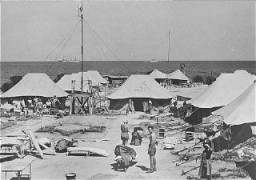
Runners competing in the 800-meter race at the Olympic games in Berlin. In this photograph, American John Woodruff is just visible in the outside lane. He came from behind to win the race in 1:52.9 minutes.Source record ID: 95/73/12A.
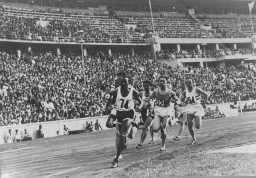
The accused and their defense attorneys in the courtroom during the International Military Tribunal. Nuremberg, Germany.
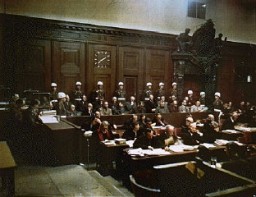
The Aigner family of Nove Zamky, Czechoslovakia. The town was occupied by Hungary. Laszlo (Leslie) Aigner (standing, back) survived the Auschwitz camp; his mother (seated) and sister Marika (standing, right) were gassed there. May 1944.
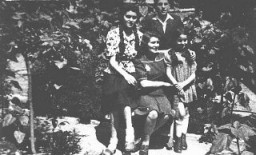
Members of the Zoska battalion of the Armia Krajowa stand atop a German tank captured during the 1944 Warsaw uprising. The tank was used by the battalion during its capture of the Gesiowka concentration camp. Warsaw, August 2, 1944.
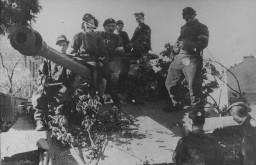
President Franklin D. Roosevelt and British Prime Minister Winston Churchill during the Atlantic Conference on Placentia Bay in Newfoundland, Canada. Also pictured are the president’s sons, Franklin D. Roosevelt, Jr. (far left) and Elliott Roosevelt (far right). August 9, 1941.

Wearing numbers, the defendants in the Bergen-Belsen Trial sit in the courtroom in Lüneburg, Germany. The Belsen Trial began on September 17, 1945, and was one of the first war crimes trials held after World War II. IWM (HU 59545)
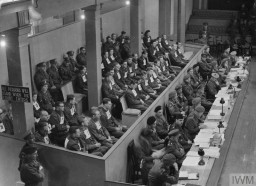
A view of the Bergen-Belsen concentration camp after the liberation of the camp. Bergen-Belsen, after April 15, 1945.The 63rd Anti-tank Regiment and the 11th Armoured Division arrived at the Bergen-Belsen concentration camp on April 15, 1945. When British troops entered the camp, they were totally unprepared for what they found. Inside were about 55,000 prisoners, many of whom were emaciated and ill and in desperate need of medical attention. Thousands of corpses in various stages of decomposition lay…
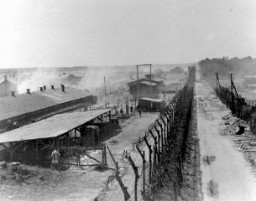
The Black Wall, between Block 10 (left) and Block 11 (right) in the Auschwitz concentration camp, where executions of inmates took place. Poland, date unknown.
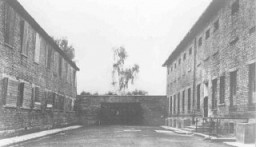
The bodies of Jewish women exhumed from a mass grave near Volary. The victims died at the end of a death march from Helmbrechts, a subcamp of Flossenbürg. Germans were forced to exhume them in order to give the victims proper burial. Volary, Czechoslovakia, May 11, 1945.
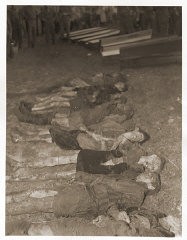
The Boerneplatz synagogue in flames during the Kristallnacht pogrom (the "Night of Broken Glass"). Frankfurt am Main, Germany, November 10, 1938.

A postwar photograph of the Breendonk internment camp in Belgium.In August 1940, the Germans, who had occupied Belgium in May of that year, turned the fortress into a detention camp.
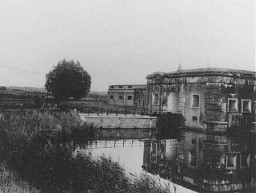
The charred corpse of a prisoner killed by the SS in a barn just outside of Gardelegen. The SS guards locked the prisoners, who were on a death march from the Dora-Mittelbau camp, in a barn, which was then set ablaze. Gardelegen, Germany, April 16, 1945.This image is among the commonly reproduced and distributed, and often extremely graphic, images of liberation. These photographs provided powerful documentation of the crimes of the Nazi era.
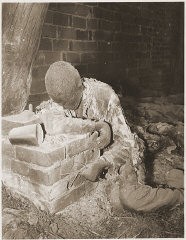
The charred remains of former prisoners in two crematoria ovens in the newly liberated Buchenwald concentration camp. Buchenwald, Germany, April 14, 1945.This image is among the commonly reproduced and distributed, and often extremely graphic, images of liberation. These photographs provided powerful documentation of the crimes of the Nazi era.
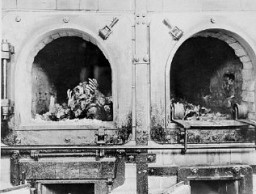
The courtroom during the Einsatzgruppen Trial of the Subsequent Nuremberg Proceedings. Chief Prosecutor Benjamin Ferencz stands in the center of the room. He is presenting evidence. Nuremberg, Germany, between September 29, 1947, and April 10, 1948.
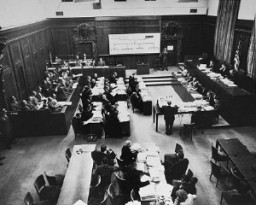
View of the courtroom as seen from the interpreters' section during the IG Farben Trial. The defense lawyers are in the foreground, the defendants are in the dock to the right, and the spectators' gallery is on the far side of the courtroom.
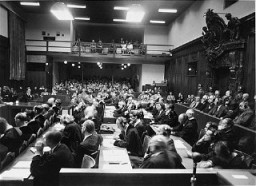
View of the courtroom during the trial of John Demjanjuk. Chief defense counsel Mark J. O'Connor addresses the court during the first session of the trial. Jerusalem, Israel, February 16, 1987.
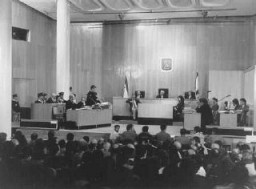
We would like to thank Crown Family Philanthropies, Abe and Ida Cooper Foundation, the Claims Conference, EVZ, and BMF for supporting the ongoing work to create content and resources for the Holocaust Encyclopedia. View the list of donor acknowledgement.